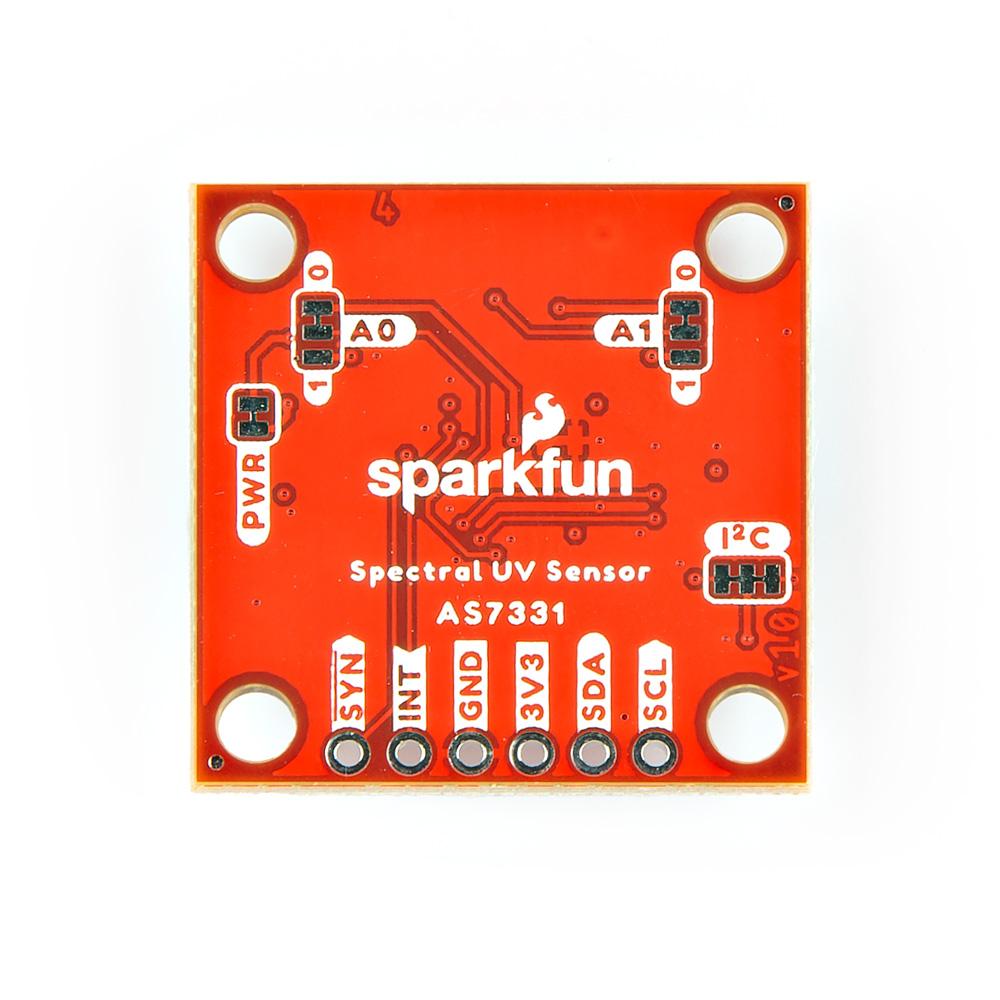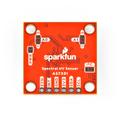SparkFun Spectral UV Sensor - AS7331 (Qwiic)

Description Attachments
The AS7331 communicates via I²C, with the breakout board routing the I²C bus pins (3.3V, GND, SDA, and SCL) to dual Qwiic connectors for easy, solderless assembly. Additionally, the board provides a 2.54mm-spaced through-hole header for those who prefer soldered connections, including the sensor's Interrupt and Sync pins. The sensor supports four I²C addresses, adjustable through A1 and A0 solder jumpers on the back of the board.
An Arduino library is available to help users quickly configure the AS7331 and start receiving UV radiation data. This library can be accessed through the Arduino Library Manager by searching for 'SparkFun AS7331' or from the GitHub repository.
Usage Examples:
Ideal for environmental monitoring, the SparkFun Spectral UV Sensor can be used in applications such as UV index measurement, weather stations, and personal UV exposure tracking. Its high sensitivity makes it suitable for scientific research and industrial applications where precise UV measurement is crucial.
Benefits:
The sensor's ability to measure across three UV channels provides comprehensive UV radiation data, enhancing the accuracy of your projects. The low power consumption, especially in power-down mode, makes it perfect for battery-operated devices. The Qwiic Connect System simplifies the connection process, reducing errors and saving time during prototyping.
Unique Properties:
The AS7331's four operating modes offer flexibility depending on your application needs, while the high dynamic range ensures accurate readings even in varying light conditions. The adjustable I²C addresses allow for multiple sensors to be used on the same bus, expanding the possibilities for complex projects.
Features:
- Operating Voltage: 2.7V-3.6V
- Current Consumption:
- Active Measurement: 1.42mA (Typ.)
- Standby Mode: 970µA
- Power Down Mode: 1µA
- Three UV Channels: UVA, UVB, & UVC
- Each with dedicated photodiode
- Four Operating Modes:
- Single Measurement
- Continuous Measurement
- Synchronized Start Measurement
- Synchronized Start/Stop Measurement
- High Dynamic Range: Up to 3.43E+10 (resolution multiplied by gain range)
- 2x Qwiic Connectors
- Four Adjustable I²C Addresses
- Set through A0 & A1 pins
- 0x74 (Default), 0x75, 0x76, & 0x77
Documents:
- Schematic
- Eagle Files
- Board Dimensions
- Hookup Guide
- Datasheet (AS7731)
- Qwiic Info Page
- SparkFun AS7331 Arduino Library
- GitHub Hardware Repo
Videos
Properties
| Brand | Sparkfun |
| Model | SEN-23517 |
| More info | Redirecting... |
| Length | 29 mm |
| Width | 29 mm |
| Height | 7 mm |
| Weight | 7 g |
Alternative products
- In stock DFRobot Gravity: UV Index Sensor (240-370nm, UVA, UVB, UVC) € 8,30 View product
- Adafruit VCNL4010 Proximity/Light sensor € 7,85 View product
- DFRobot Gravity: VEML6075 UV Sensor Module € 7,05 View product
- Adafruit VEML6070 UV Index Sensor Breakout € 6,20 View product
- DFRobot Gravity: Analog UV Sensor (ML8511) € 10,35 View product
- In stock Opencircuit BH1750FVI digital light sensor module (GY-302) € 1,95 View product
- Adafruit Flora UV Index Sensor - Si1145 Light Sensor € 9,30 View product
- Adafruit SI1145 Digital UV Index / IR / Visible Light Sensor € 10,35 View product
- DFRobot Gravity: Analog UV Sensor V2 € 6,20 View product
- SparkFun Mini Spectral UV Sensor - AS7331 (Qwiic) € 33,70 View product
- In stock Adafruit Analog UV Light Sensor Breakout - GUVA-S12SD € 6,85 View product
Customer questions
Customer Reviews
- In stock Sparkfun Copper Tape - Conductive Adhesive, 5mm - 15 meter € 6,45 View product
- In stock Sparkfun Teensy Stackable Header Kit (Extended) € 2,40 View product
- In stock Sparkfun RJ45 8-Pin Connector € 2,10 View product
- In stock Sparkfun Hobby Motor - Gear € 2,90 View product
- In stock Sparkfun Battery Holder 2xAA with Cover and Switch - JST Connector € 2,15 View product
- Sale In stock -72 % Sparkfun EasyDriver - Stepper Motor Driver € 17,60 € 5,- View product
- In stock Sparkfun Thin Speaker - 4 Ohm, 2.5W, 28mm € 2,50 View product
- In stock Sparkfun Alligator Clip with Pigtail (4 Pack) € 5,- View product
- In stock Sparkfun Toggle Switch € 2,75 View product
- In stock Sparkfun Clear Plastic Knob € 1,45 View product
- In stock Sparkfun Resistor 1K Ohm 1/4 Watt PTH - 20 pack (Thick Leads) € 1,80 View product
- In stock SparkFun Logic Level Converter - Bi-Directional € 4,25 View product
- In stock SparkFun Serial Basic Breakout - CH340G € 9,50 View product
- In stock Sparkfun Super Capacitor - 10F/2.5V € 5,20 View product
- In stock SparkFun Nano Power Timer - TPL5110 € 9,05 View product










